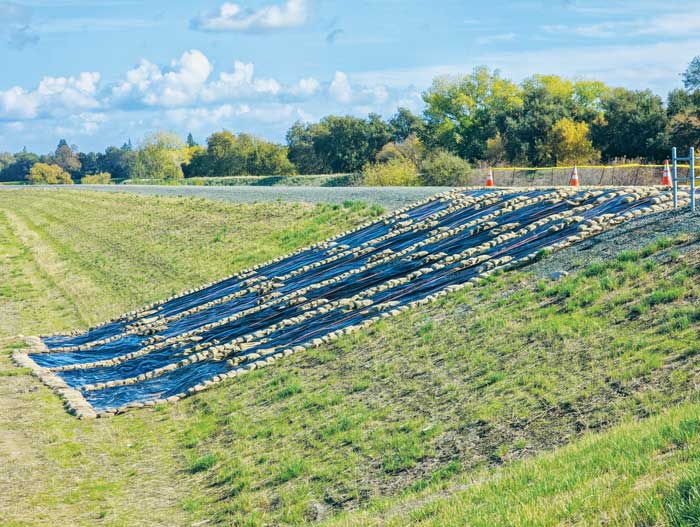
Geotextiles: Transforming Infrastructure Sustainability
Strict government compliance such as mandate use of geosynthetics by US EPA in landfills under the Resource Conservation and Recovery Act (RCRA) and infrastructural development in India and Brazil is anticipated to contribute the market growth due to over the forecast period.
Geosynthetics is an emerging field offering various applications globally. It refers to the planar products synthesised from polymeric materials used with geo materials like soil, earth, sand etc. for applications like transportation, hydraulics, roads, embankment, retaining walls, canals, erosion control, waste landfill, revetments etc. Geosynthetics have been increasingly used in geotechnical, environmental engineering and civil engineering replacing the use of conventional, restricted or expensive construction materials. These materials have long term durability, high strength and stiffness.
History of geosynthetics
History of geosynthetics is long back when linen, bamboo, reeds, timber, grass mats and other natural elements were found during excavation of ancient structures. Geotextiles made with natural fibres or vegetation was usually reinforced with soil to improve road stability.
The first use of woven fabrics as filter fabrics or construction fabrics was in 1950s and 1960s in coastal and hydraulic engineering in the Netherlands, Germany, and the United States. Carthage Mills’ president along with the University of Florida developed a woven synthetic filter fabric to protect erosion from Florida storm in 1957.RJ Barrett worked on geotextiles for erosion control. He was recognised as a “father of filter fabrics”. The Dutch used geotextiles in Delta Works flood protection scheme in the early 1960s which was honoured as one of the Seven Wonders of the Modern World by The American Society of Civil Engineers (ASCE). Since then in 1970s there was emerging use of nonwoven fabrics in several European countries and woven fabrics in the United States. Many smaller textile companies like TenCate, Carthage-Mills and large chemical companies like ICI, Rhone-Poulenc, Enka/AKZO in Europe and DuPont, Phillips, in the United States drives this early technology. Carthage Mills and USACE participated in the construction of a full-scale embankment test section at Pinto Pass in Mobile, Alabama by which the first effective design criteria and construction techniques for “fabric-reinforced embankments on extremely soft soils” was developed.
The terms “geotextile” and “geosynthetics” were first coined by Dr. JP Giroud in a seminal paper and presentation at First International Conference on Geosynthetics (1 ICG) in Paris in 1977 during presenting a paper on the Valcros Dam in France. His early 1970s work included the first use of a double-liner system, geotextile cushion with a geomembrane, and a geotextile for filtration and internal integrity of a dam embankment. Prof. Heerten along with NAUE manufacturer in Germany worked for innovations in needle punched nonwoven geotextiles for advancement in geosynthetic clay liner materials.
Raw material for geosynthetics
The selection of geosynthetic raw material depends on performance required in field and its cost. On the basis of material used for manufacturing geosynthetics it is broadly classified into two
Usual geosynthetics: These materials are adaptive to environment and provide long term functions such as high resistance to instantaneous loads, high initial strength retention etc. These are mainly produced from synthetic polymers
Green geosynthetics:These materials are made of eco-environmental biodegradable polymeric resins or natural materials that can degrade after service period leaves no harm to the soil and environment. These materials maintain their performance such as durability, design strength, hydraulic property etc. throughout the service period.
So, different fibres and polymers from both natural as well as synthetic category are used in geosynthetics for various applications which are given below.
Natural fibres:Initially natural fibres in fibre, yarn and knit form were used in geosynthetic products. With the development of non-woven and woven type products, demand for natural geosynthetic products. Due to its quick biodegradability and small scale production it couldn’t be used much. However advantage of being eco-friendly materials, the utility of geosynthetic products in civil engineering as slope stabilization, erosion control, drainage, etc has recently begun to reappear. These materials are used in the form of paper strips, jute nets, wood shavings or wool mulch.
The raw materials of the products include cotton, jute, coir, straw, ramie, bamboo, coconut etc. Ramie possesses highest tenacity among all plant fibres. Jute has the ability to mix with the soil and serve as a nutrient for vegetation. Jute geotextile could be manufactured with specific properties treatment and blending. Its use as prevention of top soil erosion and cracking is quite good. Jute geotextiles after degradation forms lignomass which enhances vegetative growth, soil organic content, fertility and stability of soil.
Synthetic polymers:The main synthetic polymers widely used as the raw material for geosynthetics are as follows
- Polypropylene (PP):It is one of the most widely used polymer for geosynthetic applications because of its low cost, acceptable tensile properties, and chemical inertness. Due to its low density it has extremely low cost per volume. The main disadvantage of polypropylene is its poor sensitivity to UV. In addition, at high temperature, its performance is easy to deteriorate, demonstrating poor creep characteristics due to low glass transition temperature.
- Polyesters (PET):The polymer in fibre form has high strength modulus, creep resistance and general chemical inertness due to which it is more suitable for geotextiles. It possesses high resistance to ultraviolet radiations. Due to its high melting point temperature, it can be used at high temperature. However, polyester can hydrolyse at pH above 10.
- Polyethylene (PE): These polymers are mainly used in making geomembranes. Based on strength requirement, following three main groups of polyethylene are used, i.e, Low density polyethylene (LDPE, density 9.2-9.3 g/cc), Linear low density polyethylene (LLDPE, density 9.20-9.45 g/cc) and High density polyethylene (HDPE, density 9.40- 9.6 g/cc)
- Polyamides (PA):Nylon 6 and Nylon 6, 6 are rarely used in geosynthetic applications. They have more strength but less modulus than polypropylene and polyester. They are also prone to hydrolysis.
- Polyvinyl chloride (PVC):Polyvinyl chloride is a hard plastic material. Flexible material can be made with the addition of plasticizers which is mainly used in geo membranes and thermo plastic coating materials.
- Polystyrene (PS):It is a light weight material of low density, mainly used in making of geofoams.
- Ethylene copolymer Bitumen (ECB):Ethylene copolymer bitumen membrane has been used in civil engineering works as sealing materials.
- Chlorinated Polyethylene (CPE):Sealing membranes based on chlorinated poly ethylene are generally manufactured from CPE mixed with PVC or sometimes PE.
Additives such as antioxidant, UV absorbers, thermal stabilizers, flame retardents, antibacterial agents etc are generally added to enhance the performance of geosynthetics. Carbon black is mainly added for long term UV resistance and high strength.
Table 1 shows the types of polymers and their formulations for use in geosynthetics.
Table 1: Type of polymers and their formulations
| Type | Resin (%) | Plasticizer (%) | Fillers (%) | Carbon Black (%) | Additives (%) |
| Polypropylene | 85-98 | 0 | 0 | 2-3 | 0.25-1 |
| Polyester | 98-99 | 0 | 0-10 | 0.5-1 | 2-5 |
| Polyethylene | 95-98 | 0 | 0 | 2-3 | 0.25-1 |
| Polyvinyl Chloride | 50-70 | 25-35 | 0-10 | 2-5 | 2-5 |
| Polyamide | 98-99 | 0 | 0 | 0.5-1 | 0.5-1 |
| Polystyrene | 98-99 | 0 | 0 | 0 | 1-2 |
Types of geosynthetics
There are multiple types of geosynthetic materials in application which are given in Table 2.
Table 2: Type of Geosynthetics
| Types of geosynthetic material | Applications |
| Geoembrane | Fluid barriers |
| Geogrid | Reinforcement material |
| Prefabricated vertical drains (PVDs) | Soil consolidation |
| Geocells | Soil construction |
| Geotextile | Separation/Filtration |
| Geocomposite | Drainage application |
Manufacturing of geosynthetics
Manufacturing techniques of geosynthetics given in Table 3.
Table 3:Manufacturing of geosynthetics
| Geosynthetics | Process | |
| Geotextiles | Non-Woven | Dry laid, Spun laid |
| Woven | Weaving | |
| Knitted | Wrap or Weft knitting technique | |
| Geogrids | Integral Junction | One or multi directional drawing of extruded sheets |
| Fused Junction | Bonding of strips by sonic welding | |
| Woven Junction | Interweaving of strips at multiple level | |
| Knitted | Warp knitting process | |
| Geonets | Using a counter rotating die. Extruded as a tube. | |
| Geomembranes | calendaring and/or spread coating | |
| Geocuspates | Extruded sheets in form of cups or studs | |
| GCLs | Sodium bentonite is bonded with upper and lower layer of GT by inert adhesive, stitching or by needle punching. | |
| Geocomposites | Combination of geosynthetics by Adhesive bonding/Heat lamination Stitching/Welding | |
| Geocell | Bonding of geo sheets in cellular form | |
Functions of geosynthetics
Separation:Geosynthetic material canseparate two kinds of materials such as soil/aggregates yet allow the free passage of liquids/gasses. Commonly used in between subbase/subgrade and around drainage materials.
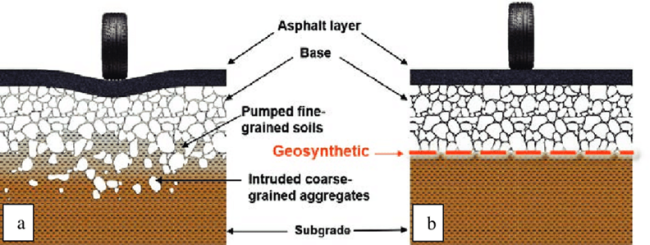
Filtration:Geosynthetic materials which are permeable in nature can allow water and liquids to pass though while restraining soil particles when flow is perpendicular to the material. This helps in prevention of soil, sand and other small particles.
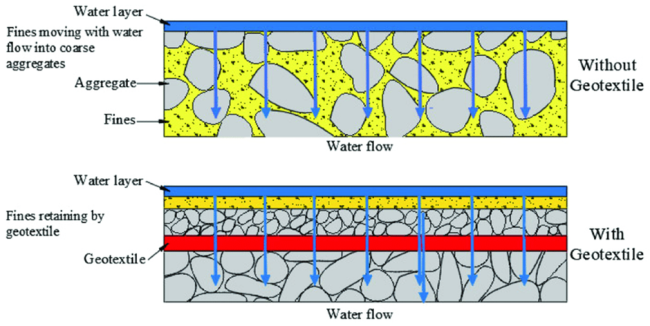
Drainage:Fluids and gases flows along the plane of geosynthetic material acts as a drainage channel. Geotextile material can collect water and discharge slowly along the geotextile.
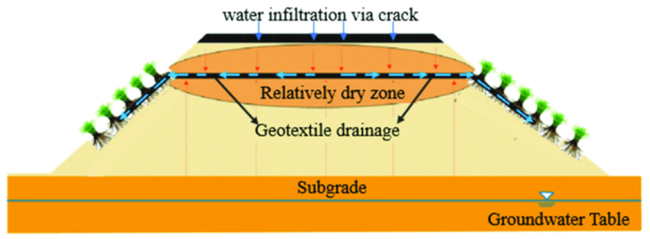
Reinforcement:The reinforcement function of geosynthetic material is most commonly used in geotechnical engineering. Tensile modulus, tensile strength, and surface friction are the three important properties of material used in geosynthetic application. It forms a reinforced composite soil when placed in the soil as a reinforcing material. The strength and deformation performance of the reinforced composite soils are improved enable steep slopes and soil structures to be constructed over weak and variables soils. It also prevents soil erosion.
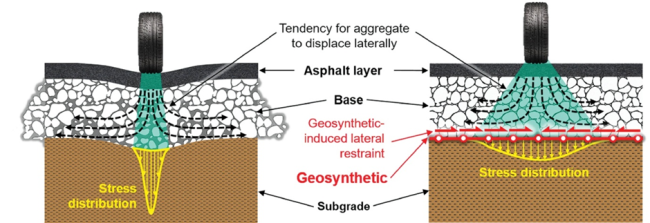
Protection: Geosynthetic materials protect the environmental soil from being erosion when used with the soil.

Containment:Geosynthetic materials help in isolating one material from another. This function is mainly used in landfill where geomembrane lining is placed to prevent the surrounding soil from being contaminated by inner waste.
Barrier:Geosynthetic materials act as a barrier between two kinds of materials as in GCLswhen hydrated sodium bentonite swells 10 times of its original weight becomes effective barrier for liquid or gas.

Energy Absorber:Geosynthetic materials placed as a lining under construction of roads, railways and building helps in absorbing energy caused during road traffic, running rails or during earthquake.
Thermal Insulation: Geosynthetic mainly geoforms are used as a thermal insulation materials in building construction.
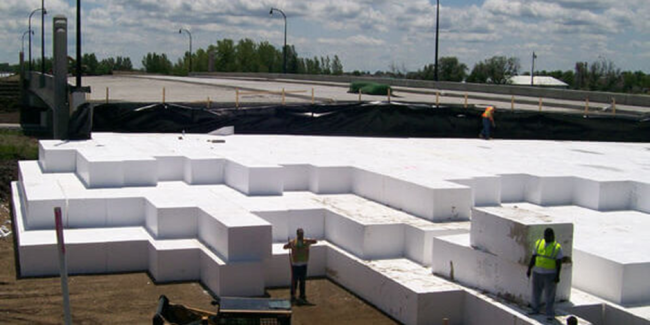
Different types of geosynthetic materials used in different applications are shown in table 4
Table 4:Types of geosynthetic and function

Application of geosynthetics
Geosynthetic materials are used in various applications. Some of them are listed below
- Landfill engineering
- Geotechnical engineering
- Coastal protection
- Rockfall protection
- Canal lining
- Flood control
- Drainage system
- Infrastructure
Market survey of geosynthetics
In 2019, the global geosynthetics market size was valued at $13.96 billion and is expected to grow at a compound annual growth rate (CAGR) of 5.6 per cent from 2020 to 2027. Lockdown measures imposed by the governing authorities to contain the spread of coronavirus are expected to create uncertainty regarding the growth of the market in the next couple of years. Strict government compliance such as mandate use of Geosynthetics by US EPA in landfills under the Resource Conservation and Recovery Act (RCRA) and infrastructural development in India and Brazil is anticipated to contribute the market growth due to over the forecast period.
Product wise market share of geosynthetics: The geotextile product segment led the market and accounted for a 48.86 per cent share of the global revenue in 2019. Geomembranes are estimated to expand at a CAGR of 4.4 per cent in terms of revenue from 2020 to 2027 for application as floating covers for reservoirs to control evaporation, reduce the Volatile Organic Compounds (VOCs) emission, and minimise the demand for drainage and cleaning. Percentage wise distribution of geosynthetic product consumption is given in Figure 2.

Figure 2: Global geosynthetics market share by product 2019 (%)
Regionwise market share by geosynthetics:Asia Pacific led the market and accounted for over 41.0 per cent share of the global revenue in 2019. Developing economies like China and India is expected to drive the regional market over the forecast period due to rising demand for oil reinforcement in the foundation work of residential buildings.
Europe accounted for over 20.0 per cent share of the global revenue in 2019 due to various construction directives, such as 89/106/EEC and M/107 European Union, which has mandated the application of geosynthetics for infrastructure projects. Also German government imposed stringent regulations related to waste management practices in the municipal and industrial sectors.
Central and South America, including Brazil are likely to increase the use of geosynthetics due to increasing in infrastructural activities in the coming years. Offshore oil and gas sector in Argentina, Venezuela, and Brazil is likely to drive the regional market. Increasing civil and commercial construction activities in the region of Middle East and Africa are likely to increase the demand of geosynthetics, over the forecast period.
Key companies
Asia Pacific and the Middle East offer a competitive edge to the geosynthetics manufacturers due to expansion of manufacturing. Key companies in the market are entering into agreements with emerging companies to expand their distribution capacities, thereby increasing their market reach. Some of the prominent companies in the geosynthetics market are
- GSE Holdings, Inc.
- Koninklijke Ten Cate N.V.
- Officine Maccaferri S.p.A.
- NAUE GmbH & Co. KG
- Propex Operating Company, LLC
- Low and Bonar PLC
- TENAX Group
- Fibertex Nonwovens A/S
- Global Synthetics
- AGRU America
- TYPAR
- HUESKER Group
- PRS Geo-Technologies
- Tensar International Corporation
- Solmax
- STRATA
- TECHFAB
- MACCAFERRI
Conclusion
Geosynthetic materials are widely used in various applications and its global market demand is continuously growing. It provides cost-effective solutions for several geo technical problems. This article presented different types of geosynthetic products, its manufacturing process, functions, applications and its market survey Innovations in products, types and properties will continue to take place, adding to the already vast range of applications of these materials.
References
- C. Kelsey, “A Brief History of Geotextiles: A 40-Year Update”, Land and Water, (2014), URL- https://docplayer.net/50741230-A-brief-history-of-geotextiles.html
- R. M. Koerner, “Early background and history of geotextiles”, Geotextiles, (2016): 3-15, https://doi.org/10.1016/B978-0-08-100221-6.00001-2
- G. Heerten, “Geotextiles in coastal engineering—25 years’ experience”, Geotextiles and Geomembranes, 1.2 (1984):119-141
- H. Y. Jeon, “Review of Sustainable Geosynthetic Development Trend with Environmental Adaptive and Eco-Environmental Performances Point of View”, IntechOpen, (2019), DOI- 10.5772/intechopen.90336
- B. J. Agrawal, “Geotextile: It’s application to civil engineering-Overview”, National Conference on Recent Trends in Engineering & Technology, (2011)
- S. Jakhar, R. Charkhiya, M. Hooda, ”An Introduction to Geosynthetics Material”, International Journal of Engineering Research & Technology, 3.10 (2015)
- P. G. Nicholson, “Soil Improvement and Ground Modification Methods”, Elsevier, (2015): 189-207
- A. Patel, “Geotechnical Investigations and Improvement of Ground Conditions”, Woodhead Publishing, (2019): 61-76
- H. Y. Jeon “Polymeric Synthetic Fabrics to Improve Stability of Ground Structure in Civil Engineering Circumstance”, IntechOpen, (2018), DOI- 10.5772/intechopen.81246
- “High Performance Geosynthetics”, URL:https://www.geofabrics.com/app/uploads/download-manager-files/Introduction%20to %20Geosynthetics.pdf
- N. Touze “Healing the world: a geosynthetics solution”, Geosynthetics International, 28.1 (2021): 1-31
- “Geosynthetics Market Size, Share & Trends Analysis Report By Product (Geotextiles, Geomembranes, Geogrids, Geonets, Geocells), By Region (North America, Europe, APAC, MEA), And Segment Forecasts, 2020 – 2027”, 978-1-68038-501-4, Grand View Research, (2020), URL- https://www.grandviewresearch.com/industry-analysis/geosynthetics-market
- H. Y. Jeon “Review of Green Geosynthetics by Using Biodegradable Resins for Civil Engineering Application as Tailor-Made Materials”, Juniper Online Journal Material Science, 1.5 (2017), DOI- 10.19080/JOJMS.2017.01.555571
- Y. Sun, S. Cao, H. Xu, X. Z “Application of Distributed Fiber Optic Sensing Technique to Monitor Stability of a Geogrid‑Reinforced Model Slope”, International Journal of Geosynthetics and Ground Engineering, (2020): 6-29, https://doi.org/10.1007/s40891-020-00209-y
- S.W. Perkins, H.N. Haselton, E.C. Newma, “In-Plane Elastic Properties of Geosynthetics from In-Air Biaxial Tension Tests”, Geosynthetics International, (2020), https://doi.org/10.1680/jgein.20.00044
- S. Babu, R. Thirumalai, V. Naveen Nayak, S. Gopinath, “Experimental investigation on expansive soils using electro kinetic geosynthetics (EKG) under cyclic loading”, Materials Today: Proceedings, 37.2 (2021): 1146-1153
- F. Yi, C. Du, “Triaxial Testing of Geosynthetics Reinforced Tailings with Different Reinforced Layers”, Materials, 13.8 (2020): 1943
- S. Soni, A. Prashant, “Design of Water Retaining Embankment Using Geosynthetics for Hydraulic Conditions”, Advances in Computer Methods and Geomechanics, Springer (2020): 329-342
- J. Y. Chang, S. J. Feng, “Dynamic shear behaviors of textured geomembrane/nonwoven geotextile interface under cyclic loading”, Geotextiles and Geomembranes, 49.2 (2021): 388-398
- G. G. C. Guzman, A. Bouazza, W. P. Gates, R. K. Rowe, R. McWatters, “Hydration/dehydration behaviour of geosynthetic clay liners in the Antarctic environment”, Geotextiles and Geomembranes, 49.1 (2021): 196-209
About the authors
- T V Sreekumar is the Director at The Bombay Textile Research Association and also the Co-Founder at Technorbital Advanced Materials.
- Dr Prasanta Kumar Panda is a Senior Scientist at The Bombay Textile Research Association.
- Komal Kukreja is a Senior Scientific Officer in the Geotech Laboratory at The Bombay Textile Research Association.



